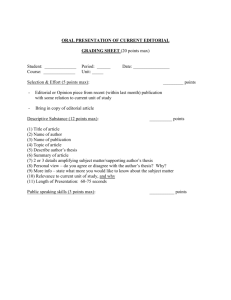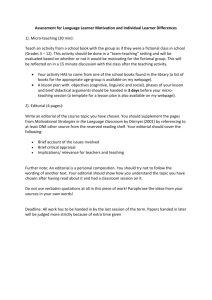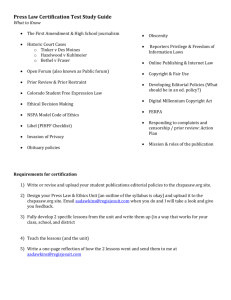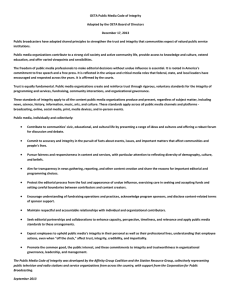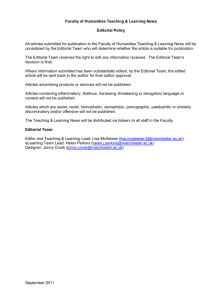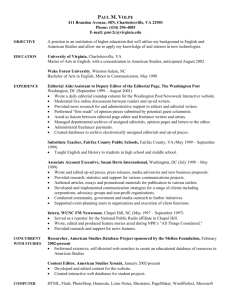Lesson plan rhetoric in editorials
advertisement
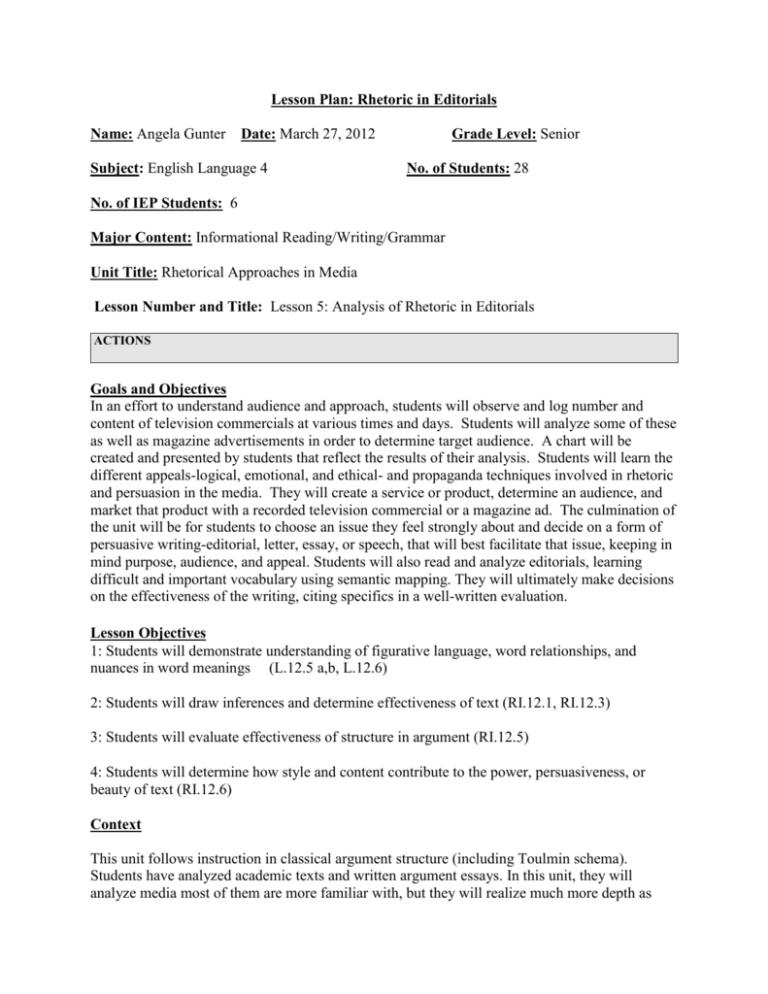
Lesson Plan: Rhetoric in Editorials Name: Angela Gunter Date: March 27, 2012 Subject: English Language 4 Grade Level: Senior No. of Students: 28 No. of IEP Students: 6 Major Content: Informational Reading/Writing/Grammar Unit Title: Rhetorical Approaches in Media Lesson Number and Title: Lesson 5: Analysis of Rhetoric in Editorials ACTIONS Goals and Objectives In an effort to understand audience and approach, students will observe and log number and content of television commercials at various times and days. Students will analyze some of these as well as magazine advertisements in order to determine target audience. A chart will be created and presented by students that reflect the results of their analysis. Students will learn the different appeals-logical, emotional, and ethical- and propaganda techniques involved in rhetoric and persuasion in the media. They will create a service or product, determine an audience, and market that product with a recorded television commercial or a magazine ad. The culmination of the unit will be for students to choose an issue they feel strongly about and decide on a form of persuasive writing-editorial, letter, essay, or speech, that will best facilitate that issue, keeping in mind purpose, audience, and appeal. Students will also read and analyze editorials, learning difficult and important vocabulary using semantic mapping. They will ultimately make decisions on the effectiveness of the writing, citing specifics in a well-written evaluation. Lesson Objectives 1: Students will demonstrate understanding of figurative language, word relationships, and nuances in word meanings (L.12.5 a,b, L.12.6) 2: Students will draw inferences and determine effectiveness of text (RI.12.1, RI.12.3) 3: Students will evaluate effectiveness of structure in argument (RI.12.5) 4: Students will determine how style and content contribute to the power, persuasiveness, or beauty of text (RI.12.6) Context This unit follows instruction in classical argument structure (including Toulmin schema). Students have analyzed academic texts and written argument essays. In this unit, they will analyze media most of them are more familiar with, but they will realize much more depth as well as the intention that goes into its production. Summary of Unit Plan Lesson 1: Defining and Recognizing Ethos, Pathos, and Logos/ Defining and Recognizing Propaganda and Logical Fallacies Lesson 3: Analysis of Rhetoric in Print Ads and Internet Ads Lesson 5: Analysis of Rhetoric in Editorials Lesson 2: Analysis of Rhetoric in Television Advertising Lesson 4: Creation of Advertising Campaign Lesson 6: Writing an Effective Editorial Connections RI.12.1: Cite strong and thorough textual evidence to support analysis of what the text says explicitly as well as inferences drawn from the text, including determining where the text leaves matters uncertain. RI.12.2: Determine two or more central ideas of a text and analyze their development over the course of the text, including how they interact and build on one another to provide a complex analysis. RI.12.3: Analyze a complex set of ideas or sequence of events and explain how specific individuals, ideas, or events interact and develop over the course of a text. RI.12.5: Analyze and evaluate the effectiveness of the structure an author uses in his or her exposition or argument, including whether the structure makes points clear, convincing, and engaging. RI.12.6: Determine an author’s point of view or purpose in a text in which the rhetoric is particularly effective, analyzing how style and content contribute to the power, persuasiveness, or beauty of the text. L.12.5: Demonstrate understanding of figurative language, word relationships, and nuances in word meanings. L.12.5a: Interpret figures of speech in context and analyze their role in the text. L.12.5b: Analyze nuances in the meaning of words with similar denotations. L.12.6: Acquire and use accurately general academic and domain-specific words and phrases, sufficient for reading, writing, speaking, and listening at the college and career readiness level; demonstrate independence in gathering vocabulary knowledge when considering a word or phrase important to comprehension or expression. Resources, media and technology “Truth is Futile When People Prefer to Believe the Lie” Editorial by Leonard Pitts Semantic Map: Word Relationships (with words from Pitts editorial) Newspapers: Editorial Pages or Internet Access to Op-Ed Columns Semantic Map: Word Relationships (blank) SOAPSS Chart with Directions SOAPSS Chart Blank Evaluation Scoring Guide Procedures Before reading “Truth is Futile When People Prefer to Believe the Lie,” students will respond to a journal prompt: “Have you ever believed in something that was later proven to be untrue? How did you take the news? Did you immediately reverse your opinion, or did it take a while for you to embrace the truth?” After everyone has written a response, volunteers will share aloud. This will help create a context for the editorial. Next, students will be given the Semantic Map: Word Relationships that includes key words from the editorial. Students will write what they think the meanings of the words are in Bubble #1 connected to each vocabulary word. Students will then look up the meanings of the words, and write the denotative definition in Bubble #2 connected to each vocabulary word. This denotative definition will not necessarily be the meaning in the context of the article. During reading, as students come to a vocabulary word, they will write the definition of the word as they read it in context in Bubble #3 connected to each vocabulary word, determining connotative meanings. Students will also be encouraged to write down any other words in the passage they do not know the meaning of or that do not make sense to them in the context of the editorial. These words will help them determine the tone and style in the SOAPSS Chart (analysis of subjects, occasion, audience, purpose, style, and scope). As we read the text aloud together, I will demonstrate annotation of the text using the document camera. I will ask students to underline words or phrases that connect to the subjects (both concrete and abstract) and make notes as we go along. I will ask questions and make statements aloud that I would usually not voice, modeling how to think critically and note connections directly on the text. After reading, students participate in a directed discussion of the vocabulary words in the context of the text in order to facilitate a deeper understanding of both the words and the passage and build on their conceptual knowledge. Students are encouraged to take notes during the discussion while I add to a class-wide map on the board, clarifying any questions as we discuss. I will then ask different students to come to the front of class and, with the help of their peers, answer the questions on the SOAPSS Chart analytical tool using the document camera. After completion of the chart, we will discuss (1) the effectiveness of the editorial, (2) why it appeared in newspapers as opposed to television, internet, radio, magazine, and (3) how it would have been received it were delivered in another form or medium. Student Assessment Objective 1: Students will read an editorial and determine which words are (1) difficult to understand, (2) central to the meaning of the text, and/or (3) contain different connotative and denotative meanings. They will list the words and complete the Semantic Map with words that help define them or are related to them. Objectives 2-4: Students will complete SOAPSS Chart analysis of the editorial they have chosen. Objectives 2-4: Students will write a three paragraph evaluation of the editorial using information they garnered from the analysis chart. Each paragraph will focus on a different analytical aspect, will include a strong topic sentence, and will include example(s) from the editorial. Accommodations for Special Populations Struggling Readers Semantic mapping is a helpful approach for students who struggle with comprehension. In addition to the mapping, striving readers could be provided with additional or extended definitions to ensure they determine the correct meaning of the words in context before reading begins. Connecting words to visuals helps many. Having students draw or find a picture of something that represents the word would aid in comprehending, making connections, and retaining vocabulary. I could also help these students during reading with their note taking, gauging their understanding, suggesting additions to their notes as necessary. Pairing struggling students with those who could demonstrate critical thinking in analysis of the text would also be helpful. Students can learn the skill by watching their peers go through the exercise, and often students gain by hearing a lesson from a perspective different from the teacher’s. Although I currently have no ELL students in my class, I have learned that letting those students add the words in their native languages or adding pictures would aid in comprehension and building of conceptual understanding. Advanced Students I encourage advanced students to read many editorials and make suggestions to the class. I also ask students who are excellent critical thinkers to articulate their thought processes in group or paired situations. Reflection/Refinement of Lesson After teaching the lesson, I realize how weak my students’ vocabulary skills are. In the future, I will use pre-test data of student Lexile reading levels and then select an article that is appropriate for the skill level of the group. Since there is such variation in reading levels in my classes, I see the advantage of grouping students in similar skill-level groups and selecting different articles specifically matched for their abilities. A search through the Literacy Design Collaborative Module Creator will provide Lexile-leveled texts. If I find other articles of interest that are not identified by reading levels, I can copy and paste them into the Lexile Network webpage to determine levels. Another way to boost vocabulary knowledge and increase connections is to let students choose words they are unfamiliar with from a list of future readings and have them prepare a presentation for the class. They would consider the denotations and connotations of the words and link them with visuals/songs/activities/etc. and connect them to previous vocabulary words, grouping them together in some way (synonyms, antonyms, etc.). These connections will be displayed on the classroom wall, and we will add to the words throughout the year to reinforce the meaning throughout the year. To help students understand the conventions of the genre, I would assign students to read several editorials by the same author and point out similarities or patterns they notice in writing or content, or they could compare and contrast different editorialists who write about the same subject. There are several syndicated editorialists who write about topics of interest to students. I will provide them with a list but also let them choose one not on the list if they prefer. I will direct students to online op-ed pages including the New York Times and the Los Angeles Times. To help students engage with this particular editorial, I would direct students to locate articles that are related to the topic of truths that many dismiss and use their findings for an extension to this assignment. They could attempt to find an editorial with the opposing opinion and write questions for a class debate. One exercise that might be useful is to have the students write a response completely agreeing with the editorial, then the next day have them write a response that opposes the assertions made in the editorial. This activity would help them with concession and refutation skills. I would first introduce them to Toulmin logic and have them complete a Toulmin schema on the topic to use as their outline. This activity could also be done orally. I could introduce an editorial and have those who say they would argue in the affirmative be assigned to refute it, while those who would have refuted it would argue for it. This activity would also help students with concession and rebuttal required in academic argument.


